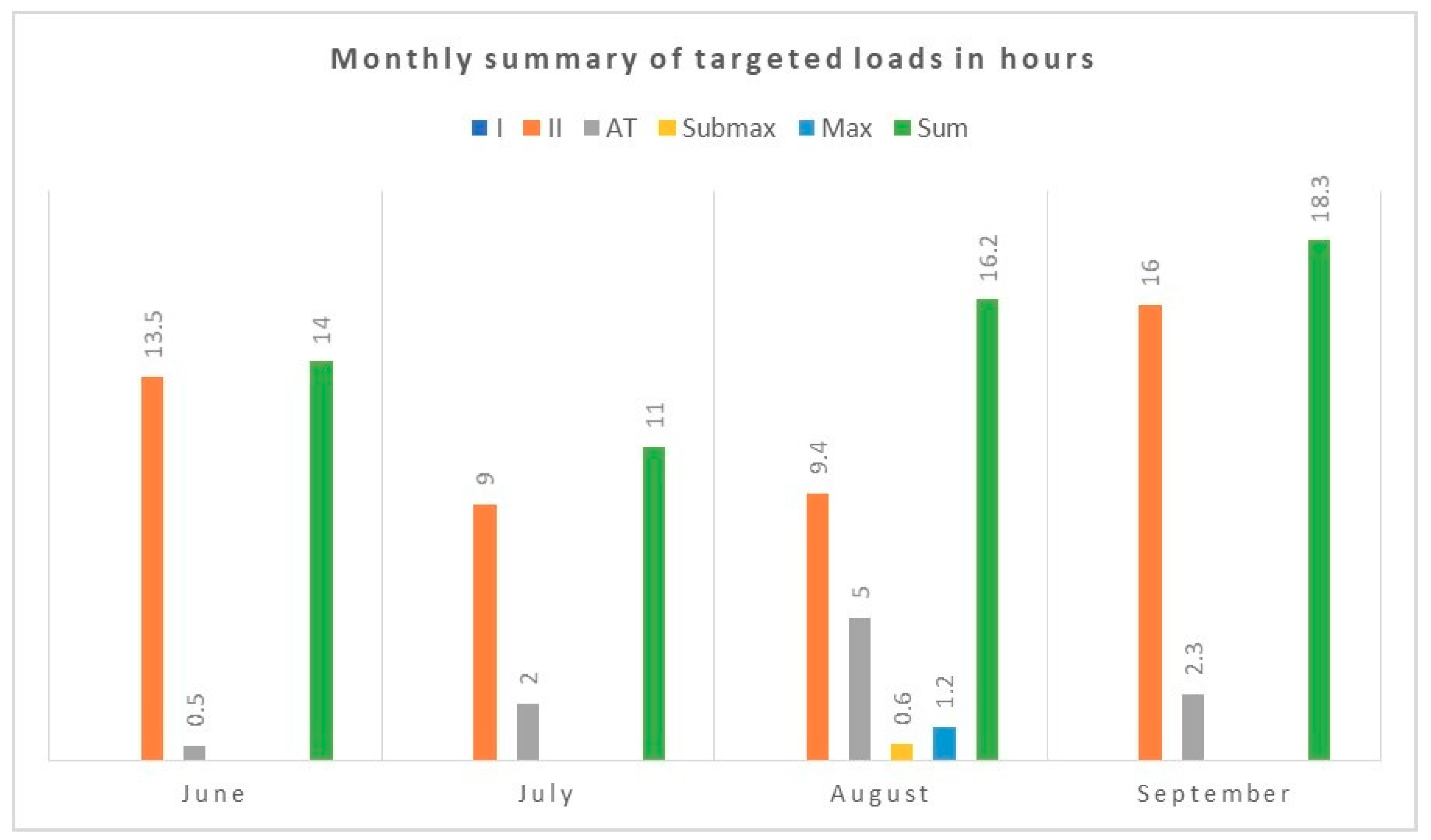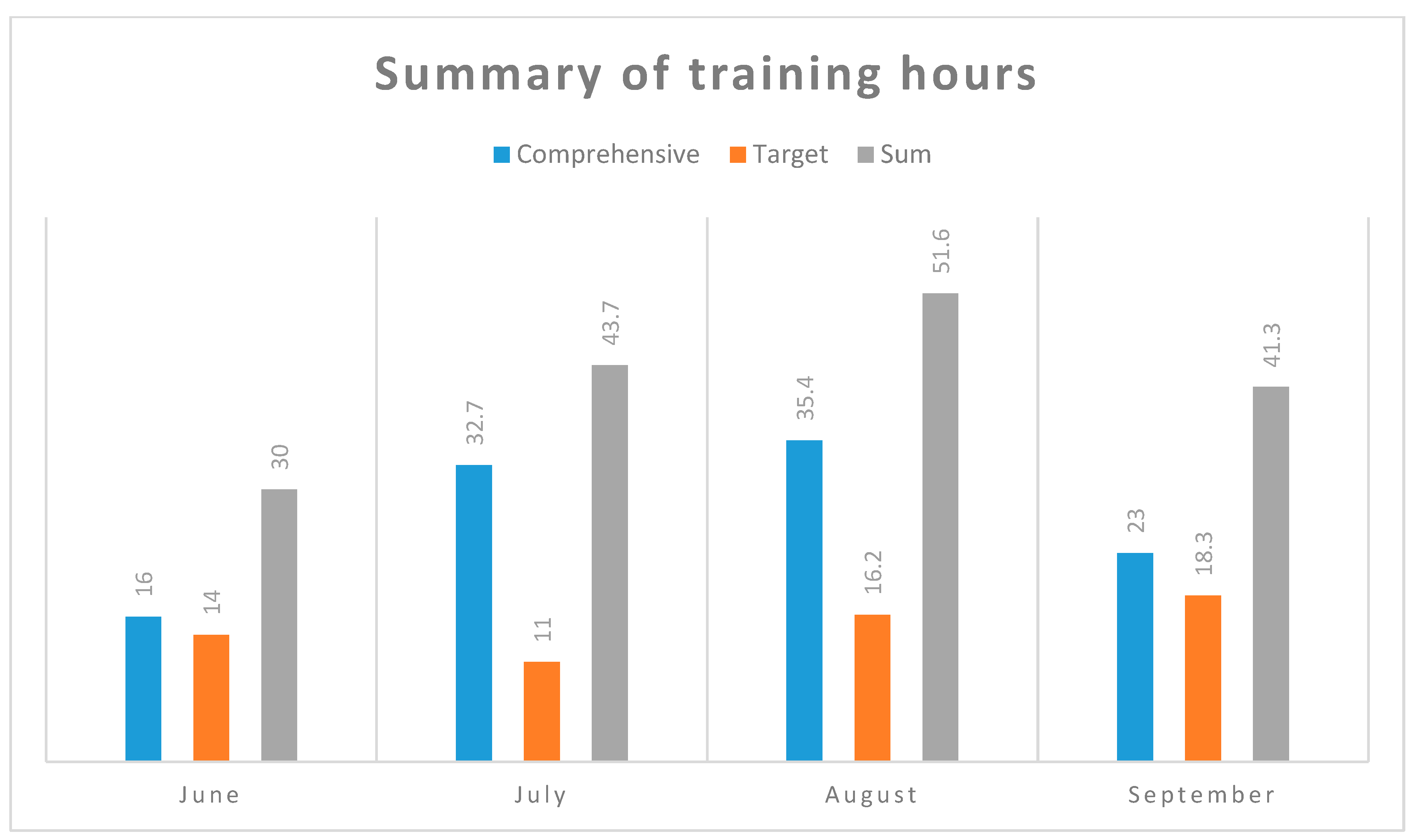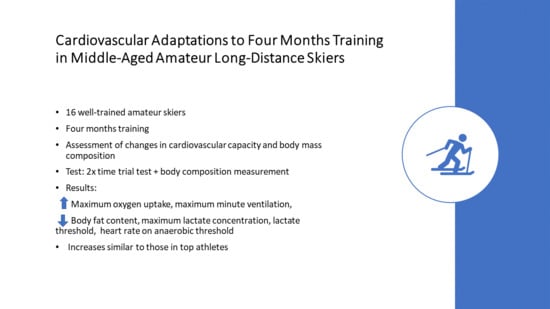Cardiovascular Adaptations to Four Months Training in Middle-Aged Amateur Long-Distance Skiers
Abstract
1. Introduction
2. Materials and Methods
2.1. Subjects
2.2. Anthropometric Measurements
2.3. Measurement of Aerobic Capacity (VO2max Test)
2.4. Training Loads
2.5. Statistics
3. Results
4. Discussion
5. Conclusions
Funding
Conflicts of Interest
References
- Sagelv, E.H.; Engseth, T.P.; Pedersen, S.; Pettersen, S.A.; Mathisen, G.; Heitmann, K.A.; Welde, B.; Thomassen, T.O.; Stöggl, T.L. Physiological Comparisons of Elite Male Visma Ski Classics and National Level Cross-Country Skiers During Uphill Treadmill Roller Skiing. Front. Physiol. 2018, 9, 1523. [Google Scholar] [CrossRef] [PubMed]
- Carlsson, M.; Assarsson, H.; Carlsson, T. The influence of sex, age, and race experience on pacing profiles during the 90 km Vasaloppet ski race. J. Sports Med. 2016, 7, 11–19. [Google Scholar] [CrossRef] [PubMed]
- Sandbakk, Ø.; Hegge, A.M.; Losnegard, T.; Skattebo, Ø.; Tønnessen, E.; Holmberg, H.C. The Physiological Capacity of the World’s Highest Ranked Female Cross-country Skiers. Med. Sci. Sports Exerc. 2016, 48, 1091–1100. [Google Scholar] [CrossRef] [PubMed]
- Sandbakk, Ø.; Holmberg, H.C. Physiological Capacity and Training Routines of Elite Cross-Country Skiers: Approaching the Upper Limits of Human Endurance. Int. J. Sports Physiol. Perform. 2017, 12, 1003–1011. [Google Scholar] [CrossRef] [PubMed]
- Padwal, R.; Leslie, W.; Lix, L.; Majumdar, S. Relationship Among Body Fat Percentage, Body Mass Index, and All-Cause Mortality: A Cohort Study. Ann. Intern. Med. 2016, 164, 532–541. [Google Scholar] [CrossRef] [PubMed]
- Holmberg, H.C. The elite cross-country skier provides unique insights into human exercise physiology. Scand. J. Med. Sci. Sports 2015, 25, 100–109. [Google Scholar] [CrossRef] [PubMed]
- Bolger, C.M.; Bessone, V.; Federolf, P.; Ettema, G.; Sandbakk, Ø. The influence of increased distal loading on metabolic cost, efficiency, and kinematics of roller ski skating. PLoS ONE 2018, 13, e0197592. [Google Scholar] [CrossRef]
- Lalond, F.; Martin, S.M.; Boucher, V.G. Preparation for an Half-Ironmantm Triathlon amongst Amateur Athletes: Finishing Rate and Physiological Adaptation. Int. J. Exerc. Sci. 2020, 13, 766–777. [Google Scholar]
- Losengard, T.; Hallén, J. Elite cross-country skiers do not reach their running VO2max during roller ski skating. J. Sports Med. Phys. Fitness. 2014, 54, 389–393. [Google Scholar]
- Bacon, A.P.; Carter, R.E.; Ogle, E.A.; Joyner, M.J. VO2max trainability and high intensity interval training in humans: A meta-analysis. PLoS ONE 2013, 8, e73182. [Google Scholar] [CrossRef]
- Hawkins, S.; Wiswell, R. Rate and Mechanism of Maximal Oxygen Consumption Decline with Aging. Sports Med. 2003, 33, 877–888. [Google Scholar] [CrossRef] [PubMed]
- Losnegard, T.; Myklebust, H.; Spencer, M.; Hallén, J. Seasonal variations in VO2max, O2-cost, O2-deficit, and performance in elite cross-country skiers. J. Strength Cond. Res. 2013, 27, 1780–1790. [Google Scholar] [CrossRef] [PubMed]
- Losnegard, T. Energy system contribution during competitive cross-country skiing. Eur. J. Appl. Physiol. 2019, 119, 1675–1690. [Google Scholar] [CrossRef] [PubMed]
- Kostić, V. Differences in aerobic capacity and spirometric parameters between athletes and nonathletes. Porto. Biom. J. 2017, 2, 184. [Google Scholar] [CrossRef]
- Grzebisz, N.; Piejko, L.; Sulich, A. Determinants of cardiorespiratory fitness in amateur male cross-country skiers. Russian J. Cardiol. 2019, 109–113. [Google Scholar] [CrossRef]
- Ehrman, J.K.; Gordon, P.M.; Visich, P.S.; Keteyian, S.J. Clinical Exercise Physiology, 2nd ed.; Human Kinetics: Champaign, IL, USA, 2009. [Google Scholar]
- Fabre, N.; Passelergue, P.; Bouvard, M.; Perrey, S. Comparison of heart rate deflection and ventilatory threshold during a field cross-country roller-skiing test. J. Strength Cond. Res. 2008, 22, 1977–1984. [Google Scholar] [CrossRef]
- Skattebo, Ø.; Losnegard, T.; Stadheim, H.K. Double-Poling Physiology and Kinematics of Elite Cross-Country Skiers: Specialized Long-Distance Versus All-Round Skiers. Int. J. Sports Physiol. Perform. 2019, 14, 1190–1199. [Google Scholar] [CrossRef]
- Calbet, J.A.; Joyner, M.J. Disparity in regional and systemic circulatory capacities: Do they affect the regulation of the circulation? Acta Physiol. (Oxf.) 2010, 199, 393–406. [Google Scholar] [CrossRef]
- Stöggl, T.; Enqvist, J.; Muller, E.; Holmberg, H.C. Relationships between body composition, body dimensions, and peak speed in cross-country sprint skiing. J. Sports Sci. 2010, 28, 161–169. [Google Scholar] [CrossRef] [PubMed]
- Øfsteng, S.; Sandbakk, Ø.; van Beekvelt, M.; Hammarström, D.; Kristoffersen, R.; Hansen, J.; Paulsen, G.; Rønnestad, B.R. Strength training improves double-poling performance after prolonged submaximal exercise in cross-country skiers. Scand. J. Med. Sci. Sport. 2018, 28, 893–904. [Google Scholar] [CrossRef] [PubMed]
- Larsson, P.; Henriksson-Larsén, K. Body composition and performance in cross-country skiing. Int. J. Sports Med. 2008, 29, 971–975. [Google Scholar] [CrossRef] [PubMed]
- Udebake, V.; Berg, J.; Tjonna, A.; Sandbakk, Ø. Comparison of Physiological and Perceptual Responses to Upper-, Lower-, and Whole-Body Exercise in Elite Cross-Country Skiers. J. Strength Cond. Res. 2019, 33, 1086–1094. [Google Scholar] [CrossRef] [PubMed]
- Rakovac, A.; Andric, L.; Karan, V.; Bogdan, M.; Slavić, D.; Klasnja, A. Evaluation of spirometric parameters and maximum oxygen consumption in athletes and non-athletes. Medicinski. Pregled. 2018, 71, 157–161. [Google Scholar] [CrossRef]
- Grzebisz, N.; Piejko, L. The impact of endurance exercise on the cardiovascular capacity of a male amateur cross country skier. Pilot study. World Sci. News 2018, 110, 72–83. [Google Scholar]
- Carlsson, M.; Carlsson, T.; Hammarstroem, D.; Malm, C.; Tonkonogi, M. Prediction of race performance of elite cross-country skiers by lean mass. Int. J. Sports Physiol. Perform. 2014, 9, 1040–1045. [Google Scholar] [CrossRef] [PubMed]
- Ettema, G.; Holmberg, H.C.; Sandbakk, Ø. Analysis of a sprint ski race and associated laboratory determinants of world-class performance. Eur. J. Appl. Physiol. 2011, 1, 947–957. [Google Scholar]
- Jeukendrup, A.; Gleeson, M. Sport Nutrition, 3rd ed.; Human Kinetics Publishers: Champaign, IL, USA, 2019. [Google Scholar]
- Dong, B.; Peng, Y.; Wang, Z.; Adegbija, O.; Hu, J.; Ma, J.; Ying-Hua, M. Joint association between body fat and its distribution with all-cause mortality: A data linkage cohort study based on NHANES (1988–2011). PLoS ONE 2018, 23, e0193368. [Google Scholar] [CrossRef]
- McGee, D.; Reed, D.; Stemmerman, G.; Rhoads, G.; Yano, K.; Feinleib, M. The relationship of dietary fat and cholesterol to mortality in 10 years: The Honolulu Heart Program. Int. J. Epidemiol. 1985, 14, 97–105. [Google Scholar] [CrossRef]
- Graf, C.; Karsegard, V.; Spoerri, A. Body composition and all-cause mortality in subjects older than 65 y. Am. J. Clin. Nutr. 2015, 101, 760–767. [Google Scholar] [CrossRef]
- Stöggl, T.L.; Hertlein, M.; Brunauer, R.; Welde, B.; Andersson, E.P.; Swarén, M. Pacing Exercise Intensity, and Technique by Performance Level in Long-Distance Cross-Country Skiing. Front. Physiol. 2020, 11, 17. [Google Scholar] [CrossRef]
- Moxnes, J.F.; Sandbakk, Ø. The kinetics of lactate production and removal during whole-body exercise. Theor. Biol. Med. Model. 2012, 9, 7. [Google Scholar] [CrossRef] [PubMed]
- Brooks, G.A. Lactate: Link beetwen glycolytic and oxidative metabolism. Sports Med. 2007, 37, 341–343. [Google Scholar] [CrossRef] [PubMed]



| Parameter Mean (Standard Deviation) | Result 1 | Result 2 | p–Value |
|---|---|---|---|
| Height (cm) | 182.2 (6.0) | 182.2 (5.8) | 1.000 |
| Body weight (kg) | 78.8 (6.3) | 78.4 (6.0) | 0.333 |
| BMI (kg/height2) | 23.7 (1.3) | 23.6 (1.2) | 0.191 |
| % body fat mass | 15.3 (2.6) | 14.6 (3.0) | 0.038 |
| Body fat mass (kg) | 12.1 (2.6) | 11.4 (2.7) | 0.023 |
| Test duration (s) | 1566.7 (130.4) | 1592.7 (133.5) | 0.267 |
| Running speed (maximum km/h) | 14.0 (0.7) | 14.2 (0.8) | 0.181 |
| VO2max (relative) (mL/kg/min) | 49.0 (4.5) | 51.1 (4.6) | 0.008 |
| VO2max (absolute) (L/min) | 3.9 (0.4) | 4.0 (0.5) | 0.054 |
| Maximum heart rate (heartbeats per minute) | 183.9 (9.8) | 182.3 (10.1) | 0.195 |
| Maximum lactate concentration (mmol/L) | 12.5 (2.8) | 10.8 (2.5) | 0.013 |
| Maximum ventilation (L/min) | 147.3 (20.5) | 151.2 (22.2) | 0.038 |
| The frequency of maximum breathing (number of breaths/min) | 59.7 (12.4) | 60.4 (10.6) | 0.410 |
| Running speed anaerobic threshold (AT) (km/h) | 11.1 (0.7) | 11.2 (0.7) | 0.575 |
| Oxygen uptake–VO2 (relative) on AT (mL/kg/min) | 44.8 (3.8) | 44.9 (3.6) | 0.934 |
| Oxygen uptake–VO2 (absolute) on AT (L/min) | 3.6 (0.4) | 3.5 (0.4) | 0.609 |
| Heart rate on AT (number of breaths per min) | 170.4 (7.7) | 168.1 (10.4) | 0.073 |
| Lactate concentration (on the threshold) AT (mmol/L) | 4.9 (1.3) | 4.0 (0.9) | 0.017 |
| AT ventilation (L/min) | 108.9 (17.9) | 112.2 (18.6) | 0.229 |
| Heart rate on AT (bpm) | 40.09 (6.2) | 43.4 (7.1) | 0.024 |
© 2020 by the author. Licensee MDPI, Basel, Switzerland. This article is an open access article distributed under the terms and conditions of the Creative Commons Attribution (CC BY) license (http://creativecommons.org/licenses/by/4.0/).
Share and Cite
Grzebisz, N. Cardiovascular Adaptations to Four Months Training in Middle-Aged Amateur Long-Distance Skiers. Diagnostics 2020, 10, 442. https://doi.org/10.3390/diagnostics10070442
Grzebisz N. Cardiovascular Adaptations to Four Months Training in Middle-Aged Amateur Long-Distance Skiers. Diagnostics. 2020; 10(7):442. https://doi.org/10.3390/diagnostics10070442
Chicago/Turabian StyleGrzebisz, Natalia. 2020. "Cardiovascular Adaptations to Four Months Training in Middle-Aged Amateur Long-Distance Skiers" Diagnostics 10, no. 7: 442. https://doi.org/10.3390/diagnostics10070442
APA StyleGrzebisz, N. (2020). Cardiovascular Adaptations to Four Months Training in Middle-Aged Amateur Long-Distance Skiers. Diagnostics, 10(7), 442. https://doi.org/10.3390/diagnostics10070442






